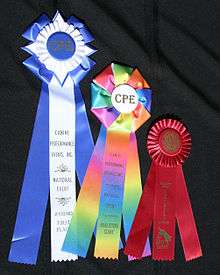Canine Performance Events

Canine Performance Events, Inc., frequently abbreviated to CPE, is a national dog agility association in the United States. It highlights having fun while trialing, offering various game classes.[1] In its rulebook, the CPE philosophy is described: "for the dog and handler to have fun while successfully competing for performance titles as a cohesive unit, achieved through positive training and teamwork".[2]
Participation requirements
Both purebreds and mixed breeds are allowed to compete, but must be at least 15 months old to compete. A dog's "permanent card", or "P-card", signifies the "lowest allowable Regular height" a dog may jump at.[3] This is based on how tall dog is at the withers as measured by an approved judge, though multiple judges must confirm a measurement in certain cases. Dogs that are blind in both eyes or aggressive cannot compete.
Classes
CPE offers seven separate classes: Standard, Jumpers, Snooker, and Jackpot, which follow the general approach of similar classes in several agility organizations, and Colors, FullHouse, and Wildcard, which are unique to CPE:
- Colors: The competitor chooses one of two short, similar numbered courses that intertwine and overlap.[4]
- Wildcard: At three places on a numbered course, the competitor chooses which obstacle to perform.[5]
- FullHouse: Very similar to Jackpot except that there is no Gamble; instead, the dog must perform a specific quantity of certain types of obstacles ("three of a kind, a pair, and a joker"), in any order, while accumulating the required number of points.[6]
Jump height
Like those of many other sanctioning bodies, jump heights range from 4 inches to 24 inches in 4-inch intervals: 4 inches, 8 inches, 12 inches, 16 inches, 20 inches, and 24 inches. There are four separate jump height categories: Regular, Veterans, Enthusiast, and Specialist. In Regular, the dog will jump at the height given on its P-card, or higher, which is its measurement at the withers rounded down to the nearest jump height. Veterans and Enthusiast competitors jump 4 inches below their P-card height. Dogs in Specialist classes will jump 8 inches below their P-card height. Regular, Enthusiast, and Specialist are all separate classes with competitors that place separately, while Veterans dogs place in the Regular class.
Class level
Six class levels are offered by CPE. Dogs who have never entered a CPE trial in the past must start at level 1, 2, or 3. Higher level courses may have or require more difficult equipment, such as weave poles. The dog moves up to a higher level by accruing a certain number of qualifying scores (runs that meet the specific time, faults, or points requirements for the specific class and level).
Junior handlers (those under 18 years of age) are eligible for several specific titles related to their handling achievements, in addition to competing and placing in standard classes.
References
- Specific
- ↑ Hodgson, Sarah (2010). Dog Tricks and Agility For Dummies (2nd ed.). Hoboken, NJ: For Dummies. ISBN 978-0-470-53959-0.
- ↑ "Canine Performance Events Rulebook" (PDF). Canine Performance Events. p. 2. Retrieved July 28, 2011.
- ↑ "Canine Performance Events Rulebook" (PDF). Canine Performance Events. p. 4. Retrieved July 28, 2011.
- ↑ "Canine Performance Events Rulebook" (PDF). Canine Performance Events. p. 13. Retrieved July 31, 2012.
- ↑ "Canine Performance Events Rulebook" (PDF). Canine Performance Events. p. 14. Retrieved July 31, 2012.
- ↑ "Canine Performance Events Rulebook" (PDF). Canine Performance Events. p. 18. Retrieved July 31, 2012.
- General
- "Canine Performance Events Rulebook" (PDF). Canine Performance Events. Retrieved July 28, 2011.